With the exception of Alaska, snakes can be found all over the United States. However, some regions have a more diverse, and more venomous, snake population than others.
California and Nevada are two western states with an abundance of snakes. Some species are completely harmless, while others you will want to steer clear of.
In this article, we’re going to take a dive into California and Nevada’s venomous snakes. Which state has more species of venomous snakes? When are they the most active? And what should you do if you are bitten by one?
How Many Species of Venomous Snakes Live in California?

The Red Diamondback Rattlesnakes is a large, venomous snake found in California.
©iStock.com/User10095428_393
California’s warm climate and diverse terrain make it the perfect habitat for a varying number of snake species. Out of California’s 33 species of snakes, 9 of them are considered venomous.
The venomous snakes that live in California include:
- Mojave Rattlesnake
- Northern Pacific Rattlesnake (Western Rattlesnake)
- Panamint Rattlesnake
- Red Diamond Rattlesnake
- Sidewinder
- Southern Pacific Rattlesnake
- Southwestern Speckled Rattlesnake
- Western Diamondback Rattlesnake
- Yellow-Bellied Sea Snake
How Many Venomous Snake Species Are Found in Nevada?
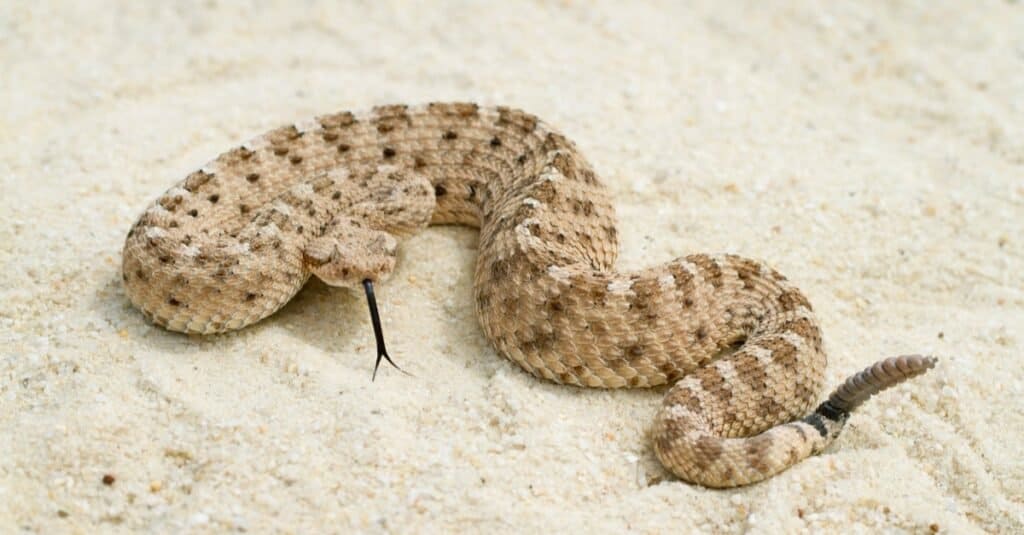
Venomous Sidewinder Rattlesnake lying on the desert sand.
©Mark_Kostich/Shutterstock.com
Nevada is home to 52 different species of snakes. Out of those, six are considered dangerous to humans and pets, and they are all rattlesnakes.
The following venomous snakes live in Nevada:
- Great Basin Rattlesnake
- Mojave Rattlesnake
- Panamint Rattlesnake
- Sidewinder
- Southwestern Speckled Rattlesnake
- Western Diamondback Rattlesnake
California vs. Nevada: Which State Has More Venomous Snakes?

More venomous snakes are found in California than in Nevada.
©iStock.com/Matthew Starling
California has more venomous snakes than Nevada. With nine venomous snake species in California, and six in Nevada, here’s how the two states compare.
| California Venomous Snakes | Nevada Venomous Snakes |
|---|---|
| Mojave Rattlesnake | Great Basin Rattlesnake |
| Northern Pacific Rattlesnake (Western Rattlesnake) | Mojave Rattlesnake |
| Panamint Rattlesnake | Panamint Rattlesnake |
| Red Diamond Rattlesnake | Sidewinder |
| Sidewinder | Southwestern Speckled Rattlesnake |
| Southern Pacific Rattlesnake | Western Diamondback Rattlesnake |
| Southwestern Speckled Rattlesnake | |
| Western Diamondback Rattlesnake | |
| Yellow-Bellied Sea Snake |
When Are Snakes Most Active in California and Nevada?
Rattlesnakes like to bask in the sun on warm days. They go through a dormant period where they hide underground during the winter and start making their appearance when the weather warms during the spring.
Rattlesnake season in Nevada and California can begin in March and run through October. During this time, rattlesnakes can be found sunning themselves during the day and hunting at night.
Northern Pacific Rattlesnake (Western Rattlesnake)
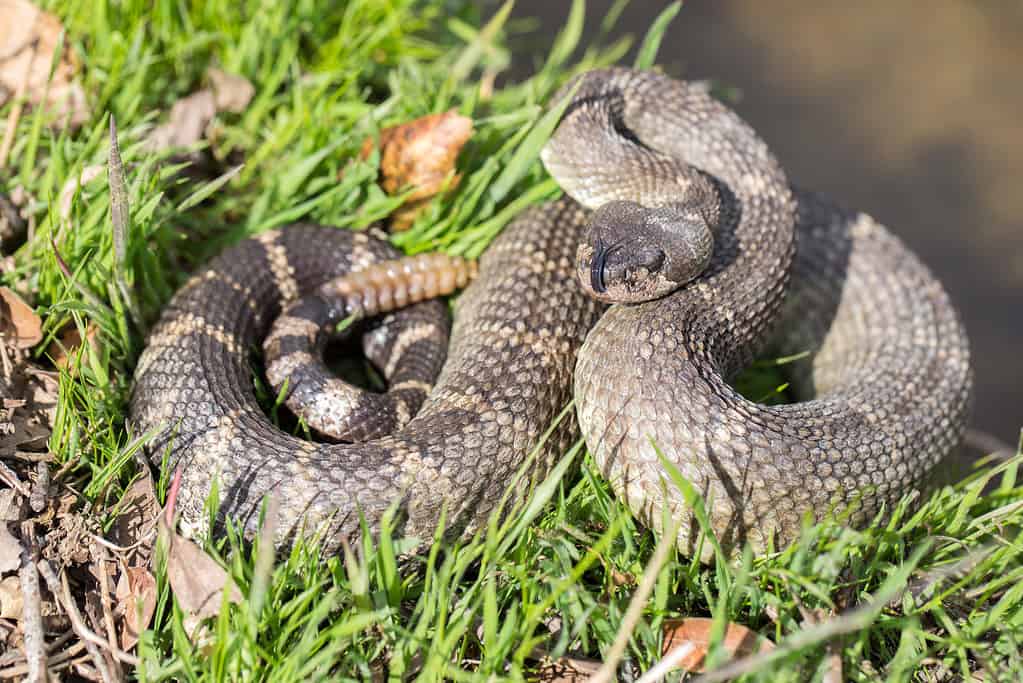
The northern Pacific, or western rattlesnake, is the most widespread and commonly found rattlesnake in California.
©iStock.com/yhelfman
The northern Pacific rattlesnake (Crotalus oreganusis), also known as the western rattlesnake, is the most widespread and commonly found rattlesnake in California.
The western rattlesnake’s average size is between two to three feet long, although they can grow as large as nearly five feet. Like all rattlesnakes, it has a big triangular head with a thin neck, a thick body, and a rattle at the tail. The western rattlesnake is typically shy and avoids encounters with people.
Southwestern Speckled Rattlesnake

Speckled rattlesnakes prefer rocky terrain.
©Creeping Things/Shutterstock.com
The southwestern speckled rattlesnake (Crotalus pyrrhus) is commonly found in Nevada. It grows around two to three feet long, and its habitat includes foothills, low mountains, and open deserts. The speckled rattlesnake gets its name from its speckled appearance on its body. Its markings help the snake camouflage in the rocks and sand of its habitat.
Yellow-Bellied Sea Snake
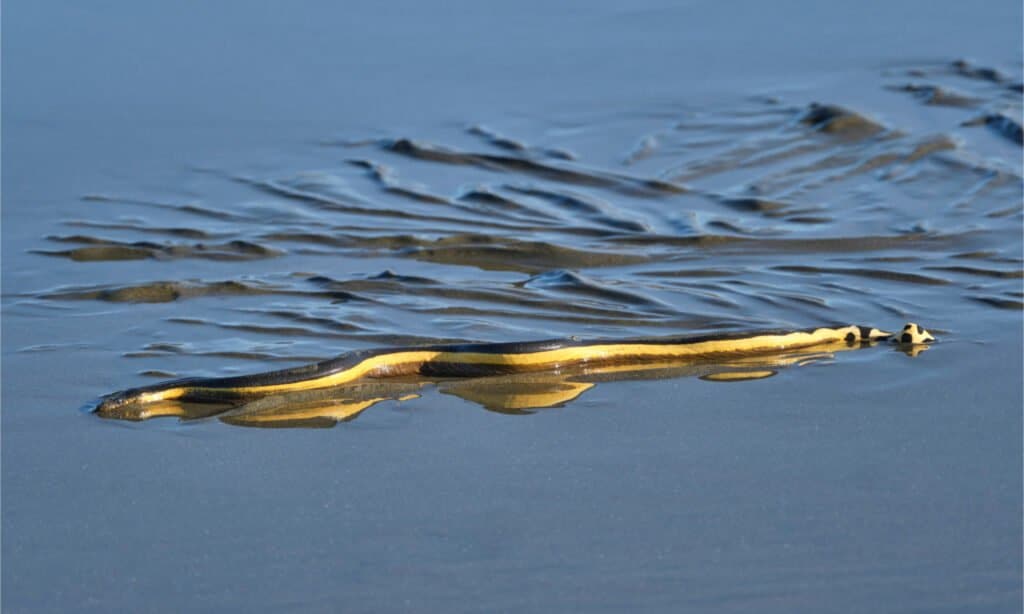
Yellow-bellied sea snakes are highly venemous.
©John Fader/Shutterstock.com
The yellow-bellied sea snake (Hydrophis platurus) is widespread in tropical waters, but only rarely seen in California. They prefer warm ocean waters. They have been found off the coast in the far southern part of the state. Although highly venomous, they aren’t considered a threat to swimmers. They usually aren’t spotted unless washed up on the beach or caught in a fishing net.
Western Diamondback Rattlesnake
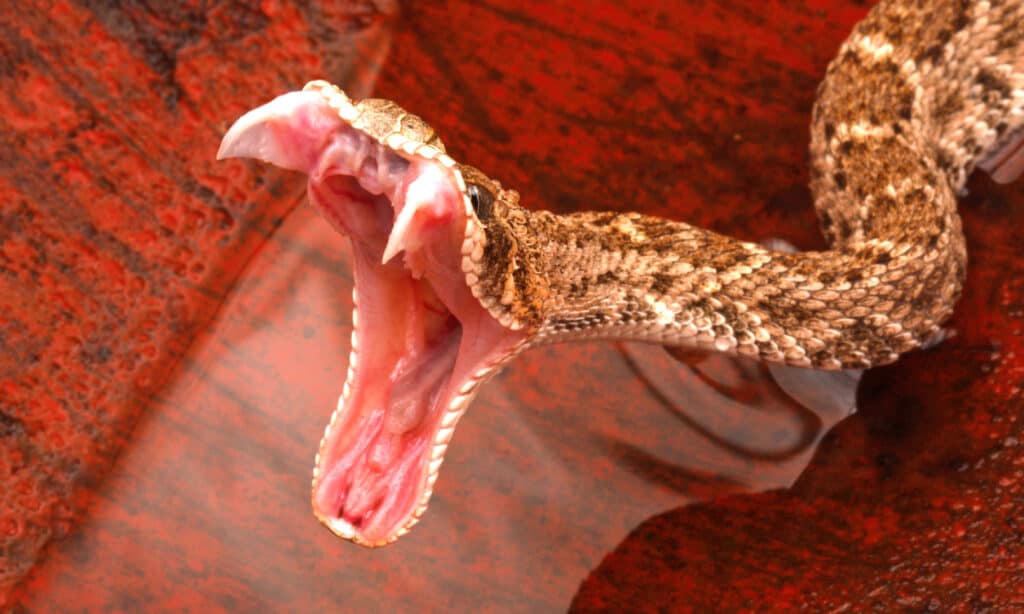
Western Diamondbacks are highly aggressive snakes.
©iStock.com/johnaudrey
The western diamondback (Crotalus atrox) makes its home in the southeast corner of California and the southern tip of Nevada. This large rattlesnake, found in the Mojave Desert is highly aggressive and venomous. Although they usually reach four feet long, the longest on record was seven feet long.
Which Snakes Have the Highest Level of Venom Toxicity?
Some of the most venomous snakes found in California and Nevada include the yellow-bellied sea snake, the western diamondback, and the Mojave rattlesnake.
Yellow-Bellied Sea Snake
This sea snake is one of the most venomous snakes in the world. Living completely in the water its entire life, this sea snake’s venom is highly toxic. Humans aren’t likely to encounter this snake unless it’s caught in a fishing net or washed up on shore.
Western Diamondback
The venom from this large pit viper immobilizes its prey by attacking the victim’s blood system. One of the most aggressive snakes found in both Nevada and California, this snake is ready to strike when disturbed.
Venom from a western diamondback snake bite can lead to a breakdown of red blood cells, causing internal bleeding and systemic symptoms.
Mojave Rattlesnake
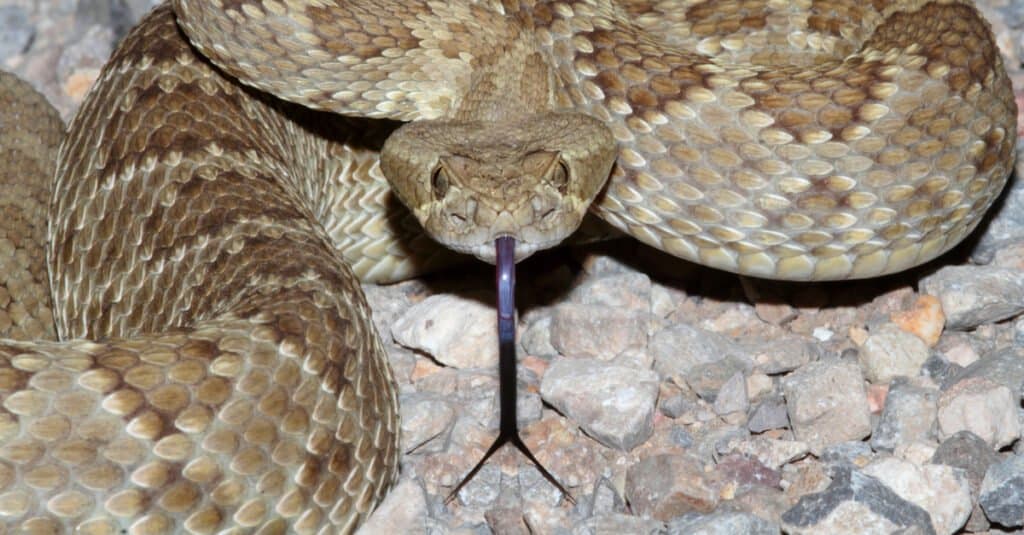
The Mojave Rattlesnake is widely considered the most deadly snake in the United States.
©Steve Byland/Shutterstock.com
Another snake with a high level of venom toxicity is the Mojave rattlesnake. A pit viper that has a similar appearance to the western diamondback, the Mojave rattlesnake is found in the Mojave desert. However, it’s much less aggressive than the diamondback and tends to avoid humans when possible.
But, when this snake does attack, it can be deadly. The Mojave immobilizes its prey with two types of venom: hemotoxic (attacks blood) and neurotoxic (attacks the nervous system.)
California vs. Nevada: Which State Has More Venomous Snake Bites?
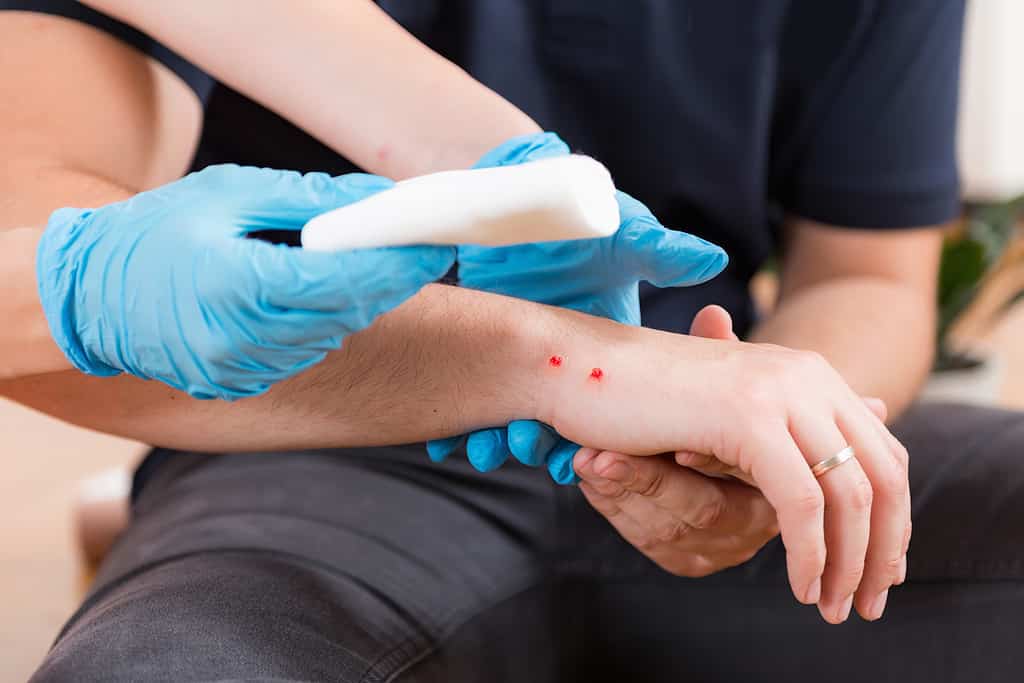
Approximately 7,000 to 8,000 people are bitten each year by venomous snakes
©Microgen/Shutterstock.com
Venomous snake bites are relatively rare given that most snakes try to avoid people. Although rare, the CDC estimates approximately 7,000 to 8,000 people are bitten each year by venomous snakes in the United States, with about five deaths per year. Further, rattlesnake bites can cause victims to suffer long-term injuries.
The California Poison Control System reports about 250 rattlesnake bites in the state per year, making it the state with more venomous snake bites.
What Should You Do If Bitten by a Venomous Snake?
Rattlesnakes generally avoid humans but will strike when threatened. Snake bites usually happen when someone walking or hiking accidentally touches a snake. Snakebites typically happen on hands, feet, and ankles.
How to Avoid Snake Bites
People living in areas where rattlesnakes are found need to be aware of safety precautions to take to avoid encounters. Rattlesnakes’ most active season is from March to October and they are most active at night. But they can be encountered anytime.
When hiking at night, be sure to use a flashlight. Wear over-the-ankle hiking boots and loose-fitting pants. Never hike barefoot or in sandals.
What to Do if You Are Bitten by a Snake
Despite every precaution, accidents do occur. If you are bitten by a snake, follow these tips:
- Remain calm.
- Call 911 and get medical help immediately.
- If it’s safe to do so, get a picture of the snake from a distance. This can help medical professionals identify the snake that bit you.
- Remove jewelry like rings that could get stuck on your finger when swelling begins.
- Wash the area if you have access to water and soap. Cover it with a clean bandage.
- If you can, keep the bite below the heart.
What Should You Not Do if Bitten by a Snake?
There are some myths about snake bites that can cause further harm and need to be avoided. These include the following:
- DON’T make incisions over the bite wound
- DON’T apply a tourniquet (this restricts blood flow)
- DON’T ice the wound
- DON’T suck out the poison with your mouth.
Over-the-counter snakebite kits can be useful while you’re waiting to get professional treatment. These usually consist of a suction device to remove the venom.
Once you reach a hospital or poison center, you will likely be treated with rattlesnake serum (antivenin.) Remember that rattlesnake bites are rarely fatal, but you should always seek treatment.
The photo featured at the top of this post is © Creeping Things/Shutterstock.com
Discover the "Monster" Snake 5X Bigger than an Anaconda
Every day A-Z Animals sends out some of the most incredible facts in the world from our free newsletter. Want to discover the 10 most beautiful snakes in the world, a "snake island" where you're never more than 3 feet from danger, or a "monster" snake 5X larger than an anaconda? Then sign up right now and you'll start receiving our daily newsletter absolutely free.
Thank you for reading! Have some feedback for us? Contact the AZ Animals editorial team.






